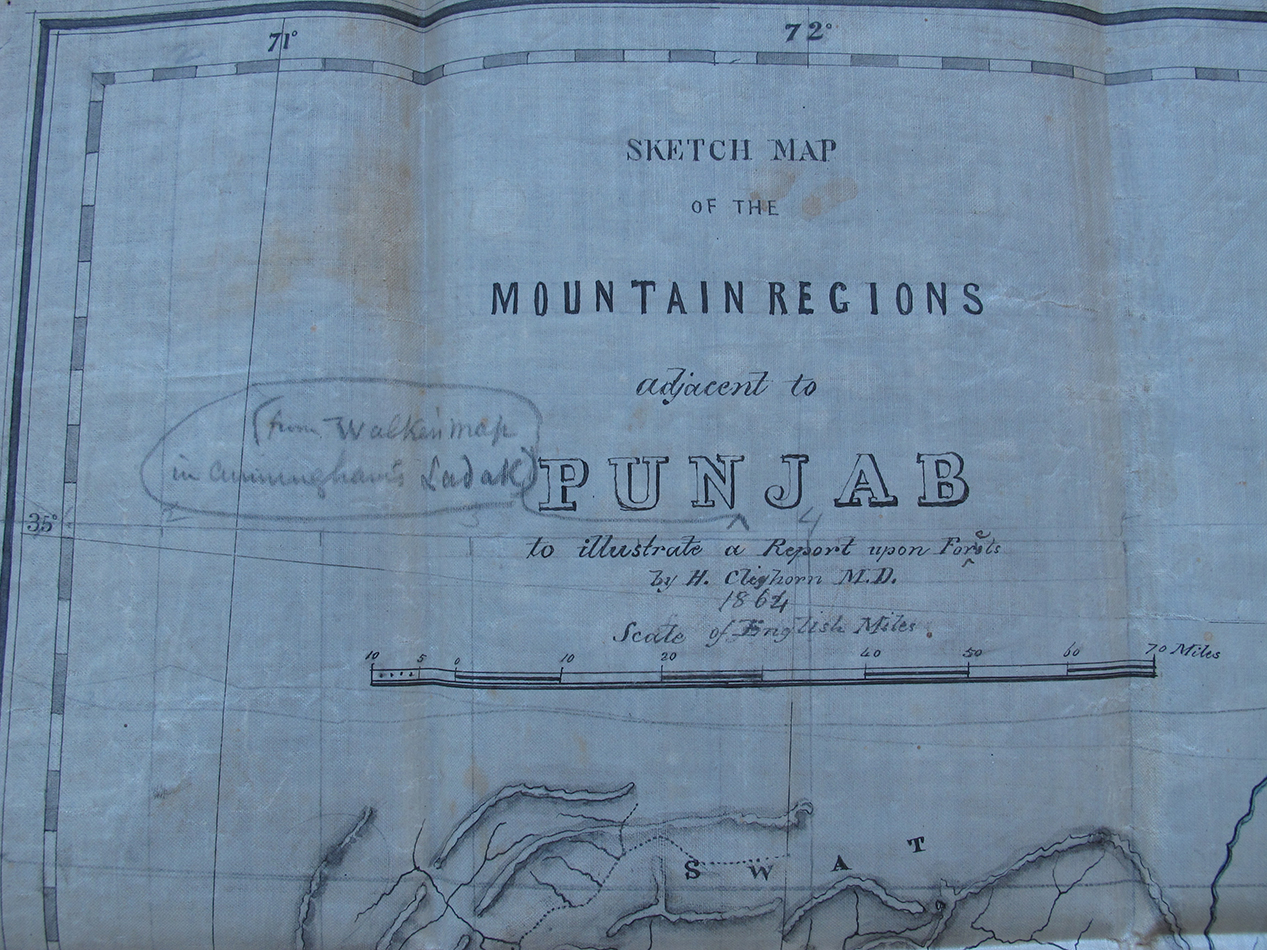Following Hugh Cleghorn to the Western Himalaya – Part II

A few weeks ago we featured a guest blog from Henry Noltie who is currently retracing the journey of Hugh Cleghorn to the Western Himalaya (Following Hugh Cleghorn to the Western Himalya). Henry has sent us the following update on his travels:
Sent 22nd August 2014
Greetings from Manali at the head of the Beas Valley. The trip is going wonderfully well, and I’ve just finished the first leg to the eastward – starting with Simla where Cleghorn hobnobbed with Viceroys (Lord Elgin and Sir John Lawrence) and worked out forest policy with Dietrich Brandis – the weather could best be described as ‘dreich’ – in fact one could see only a few yards in front of one’s nose. Very little is left, and the Viceroy’s House that Cleghorn knew has been hideously rebuilt in a style aptly described by an Indian historian as a cross between a flying saucer and a bus station. Then I went to Kotgarh to the Church Missionary Society Station where the Moravian Missionaries started their journey to Mongolia (sic) – they got no further than Keylong where I head tomorrow and where Cleghorn met up with them.
From Kotgarh I followed Cleghorn’s footsteps to the tributaries of the Jumna River (which drains into the Ganges) – the Pabar and the Tons. These are magnificent deep valleys looking lush in this monsoon season, and the rivers raging torrents – above 2500 metres the forest is astonishingly intact, and in fact there is far more than there was in Cleghorn’s time thanks to the efforts of the Forest Department that he set up the main trees are blue pine (Pinus wallichiana), deodar (Cedrus deodara), Himalayan spruce (Picea smithiana) and the West Himalayan fir (Abies pindrow) ascending in that order. Below this a zone of chir pine (Pinus roxburghii). Cleghorn was interested in useful plants and oriental plants with occidental equivalents, so it was particularly interesting to find the Indian olive (Olea ferruginea) and the Himalayan box (Buxus, forget its specific name).
It was then time to cross the great watershed of the Subcontinent – to the Sutlej, which drains to the Indus. This was the first of four of the five great rivers of the Punjab whose forests Cleghorn surveyed. The river is stupendous, but the interesting thing is that the forests are no longer ‘exploited’ (which would have horrified him) – strictly preserved in the interests of protecting watersheds – THE great natural resource is now water and there are vast Hydro schemes on the Sutlej. The highlight was a visit to Kalpa, which Cleghorn knew as Chini, to which the Governor General Lord Dalhousie had ‘bunked off’ to in 1850 as he preferred it to Simla. Perched high above the Sutlej I stayed in a hotel on the balcony of which stood the skeleton of a billiard table, with a marble top – who lugged it up to an altitude of 1900 metres. Might Dalhousie and Cleghorn have played on it? Cleghorn dumped his long suffering wife at Chini in 1862 when he went off looking for wild rhubarb. I was lucky to be there the night of an extraordinary festival when the local god and goddess had been taken out on a jaunt to a neighbouring village but were returned home in gaudily decorated palanquins preceded by a pair of vast silver serpentine horns. This scene was painted by the Glasgow artist William Simpson in 1864 only two years after Cleghorn’s visit, though as an evangelical I’m sure he would have disapproved.
I’m now in the valley of the Beas, the second of C’s Punjab rivers, Manali surrounded by wonderful deodar forests. This afternoon I went to one house that he certainly visited, Nagar Castle, sold to Major Hay, the first British Commissioner of Kullu in 1846 – Hay’s tea plantations have not survived, the whole valley is now one enormous apple orchard, and decidedly suburban in character. I also visited Sultanpur (now part of the modern Kullu, a horrible concrete jungle) where thrilled to find a positively medieval street with two shops selling herbal medicines of the sort that Cleghorn wrote about – including Nardostachys jatamansi and a local speciality ‘kuth’, which Cleghorn knew as Aucklandia veracosta (named after George Auckland, a Governor General) but now known as Saussurea costus (or it may now be S. lappa – no books to hand to check).
Enough for now – I set off for Lahoul tomorrow.
All best
Henry
N.B. Website links have been added by Special Collections.
[…] FOLLOWING HUGH CLEGHORN TO THE WESTERN HIMALAYA – PART II […]
[…] Following Hugh Cleghorn to the Western Himalaya – Part II […]